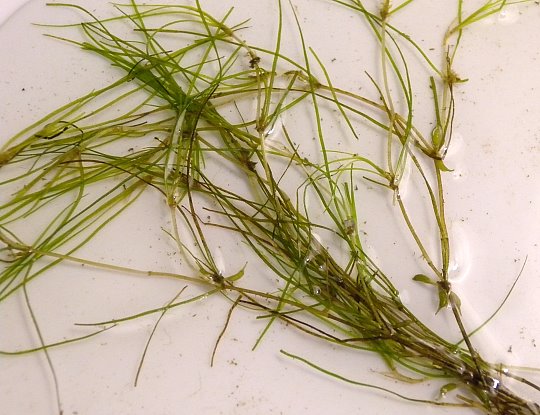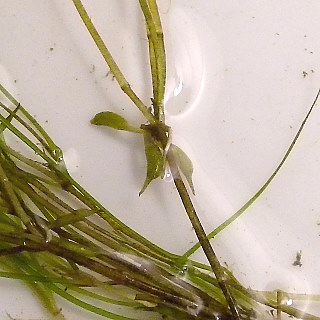
Horned Pondweed is monoecious, producing separate male (staminate) and female (pistillate) flowers on the same plant. These inconspicuous flowers are located at the bases of the leaves, where male and female flowers often occur together. Male flowers occur individually; each male flower consists of a single stamen. Female flowers occur in groups of 1-5; each female flower consists of an ovary with a style and a peltate stigma. Neither male nor female flowers have petals and sepals. The blooming period can occur from late spring into the summer. Cross-pollination of the flowers occurs underwater. Fertile female flowers are replaced by beaked fruits about 3.0-3.5 mm. in length. Each slightly flattened fruit has a curved-ovoid shape that is convex and occasionally crested on one side and either
Cultivation: The preference is full or partial sun, shallow water up to 4' deep, and a bottom that is mucky, sandy, or rocky. Either fresh or brackish water is tolerated if it is reasonably clear; the pH of the water can vary from mildly acidic to alkaline. Locations with strong currents or wave action should be avoided.
Range & Habitat: The native Horned Pondweed is occasional in northern and west-central Illinois, while in the rest of the state it is uncommon or absent. In addition to North America, this aquatic plant also occurs in Eurasia and other continents. Habitats include marshes with open water, springs and streams, drainage canals, small ponds, and protected inlets of lakes. Outside of Illinois, this plant can be found in brackish marshes and bays.
Faunal Associations: The foliage of Horned Pondweed is probably consumed by some aquatic insects, but information is currently lacking. Waterfowl consume the foliage and seeds of these plants: Examples include the Canada Goose (goslings & probably adults), Mallard, Northern Shoveler, Green-Winged Teal, Redhead, Lesser Scaup, and American Wigeon (personal observations, Martin et al., 1951/1961). This plant also provides cover for small fish, aquatic insects, and other organisms.
Photographic Location: This plant was found in Boneyard Creek on the campus of the University of Illinois in Urbana, Illinois. It was photographed indoors.

Comments: On the basis of the foliage alone, Horned Pondweed is difficult to distinguish from such aquatic plants as grassy pondweeds (Potamogeton spp.) and naiads (Najas spp.). However, its clusters of small beaked fruits are quite distinctive and they can be found on its foliage throughout most of the summer. Pondweeds produce their flowers/fruits on short spikes that are held either slightly above the surface of the water or underwater. Naiad species produce their flowers/fruits at the bases of their leaves, but they are produced individually (a single fruit per leaf) rather than in clusters. Most species of Naiad also have leaves with fine teeth that can be seen by either the naked eye or with a 10x hand lens.